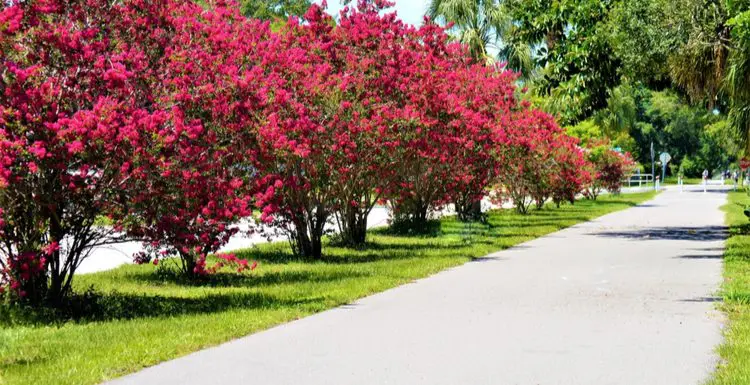The crepe myrtle bush is a flowering shrub that comes in all shapes and sizes. Below, we’ll discuss their:
- Basic information
- Planting requirements
- Pruning and care
- Potential problems
- Uses and designs
What Is the Crepe Myrtle Bush?
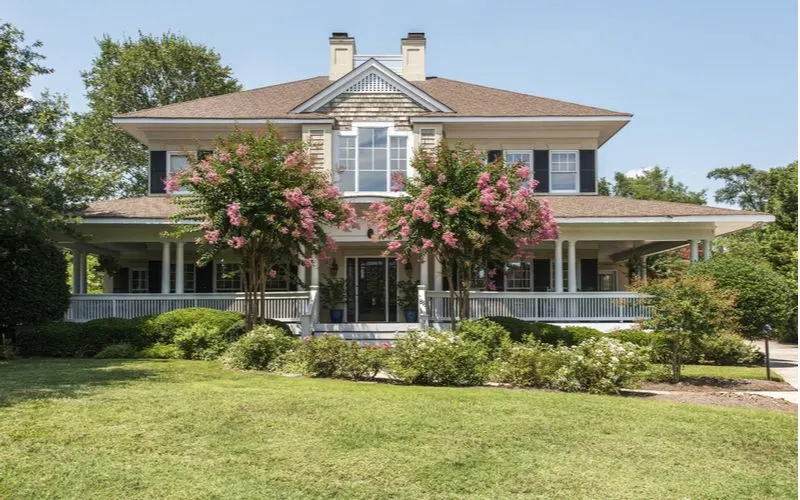
CLS Digital Arts/Shutterstock
The crepe myrtle bush, also known as Lagerstroemia indica, has multiple stems and purple, red, pink, and white flowers. They blossom in the summer and attract gorgeous pollinators to your yard.
Depending on its size variety, a standard crepe myrtle bush grows between 2 and 15 feet in height.
Dwarf shrubs are 2-5 feet tall, semi-dwarfs are 3-6 feet, and shrub-like trees are 6–15 feet. Flowering varieties often have broad crowns that extend wider than the bush’s height. The spread is about 5–15 feet wide.
Try not to confuse them with crepe myrtle trees, which can have one or more trunks and grow 20–35 feet tall. Crepe myrtle bushes can grow in USDA hardiness zones 6-10.
In the lower zones, your crepe myrtle bush risks being only root hardy; the roots survive the winter, but the branches die and grow again in spring.
However, crepe myrtle bushes can survive a light frost, drought, and poor soil quality. For the most part, these shrubs prefer warmer climates.
They’re popular in the American South for a reason. So much so that the Crape Myrtle Society of America is in McKinney, TX. They require a minimum of six hours of full sun each day and bloom between July and September.
Some varieties will keep blooming until frost hits. Their flowers come in lavender, deep red, pink, and white. Some varieties will have multiple colors.
Uses and Designs
In your yard, you can use crepe myrtle as a staple piece or as accent plant. They go well on driveways and streets because of their non-invasive roots. You can pair them with various other shrubs and bulbs as well.
If you have a small bush, you could put it in a container with other small plants. They are perfect for urban and residential gardens as well.
They make colorful add-ons to flower beds and as home borders. Or you can mix and match trees and shrubs to create colorful hedges.
Planting Requirements
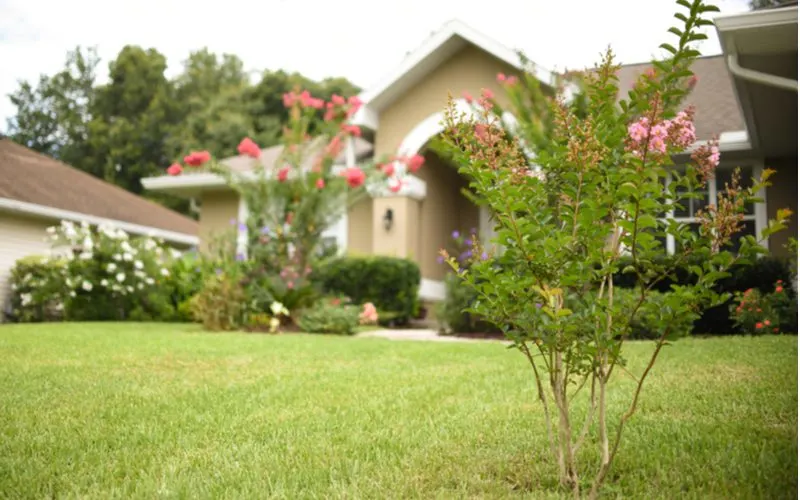
TanyaCPhotography/Shutterstock
While you can plant the crepe myrtle bush year-round, your best bet is to plant it in early spring or fall. These seasons are when you will plant deciduous shrubs because they give them time to become established.
Once established, they can tolerate heat and drought quite well. Planting them in the mild seasons will help them handle the heat of summer or the dormancy of winter.
If you plant them in the summer, make sure to water them frequently to help spur root growth, giving it the best chance of survival for the rest of the year.
Ensure you plant them in full sun or in at least a spot that gets six hours of sunlight daily. If you live in an area with a lot of clouds, you’ll likely get fewer flowers.
Crepe myrtle bushes may grow in hardiness zone 6, but they prefer zones 7–10. Overall, they can handle most soil types. You also need to give them ample drainage. Try to use a soil conditioner to help the roots expand quickly.
You can also use a starter fertilizer. When you get your crepe myrtle bush, dig a hole twice the width and the same depth as the pot it comes in. Align the tree in the middle of the hole, and backfill slowly.
Be sure to water after each backfill stage. Leave the top of the root ball above the ground to help it respirate.
If you need to, add a stake and water the plant thoroughly. Keep watering your plant once a week throughout the first growing season. You should water it twice a week if you planted it in the summer or during hot weather.
Pruning and Care
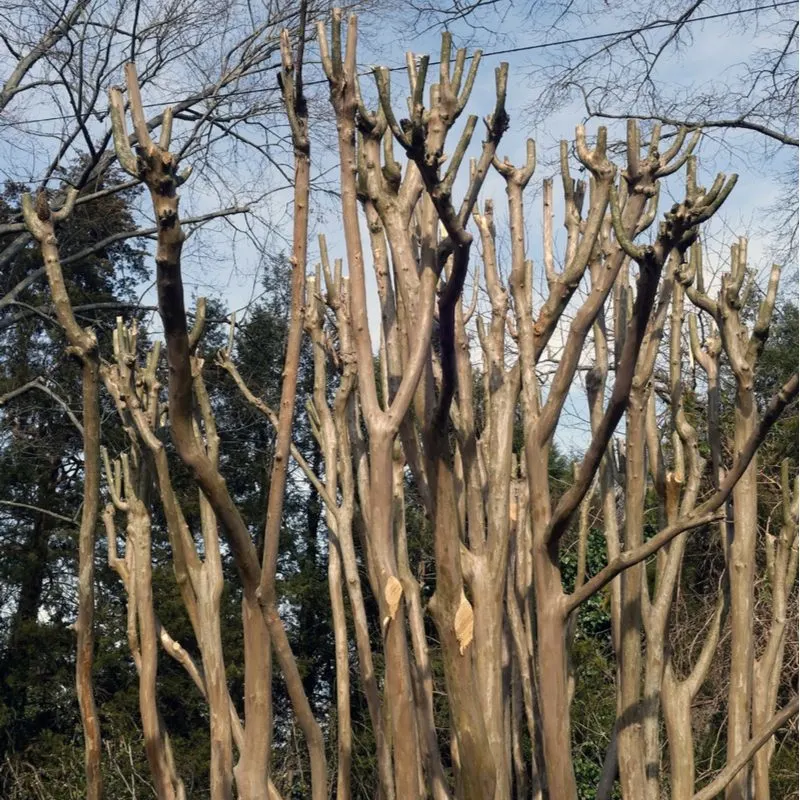
Noel V. Baebler/Shutterstock
Since crepe myrtle bushes bloom between late spring and early fall, you’ll want to prune them in the late winter while they lie dormant. Pruning them too often or severely will give your crepe myrtle scars that mar the landscape.
You will need to do more pruning during your plant’s first few years on your property. That way, you create the desired shape and encourage it to grow in that manner.
With the shrubs, you will want to thin out the branches where needed. Remove any pencil-thin branches and ones that harm the structure of the shrub.
Single-trunk trees need pruning on their side branches and basal sprouts to prevent competition from the trunk. You can trim multi-trunk ones to your desired shape. Ensure the trunks do not touch one another, and keep the center one open to allow light and air to pass.
Remove any crowded or crossed branches from the center. Also, check your bush for any diseased or dead wood. You can cut back on pruning by selecting the correct crepe myrtle. If you wanted a bush and bought a multi-trunk tree, you will need to do a lot more work.
The plant tag should tell you what size you can expect it to grow to. When the flowers fall, you will find round seed balls in their place. You can trim these during the growing season to trigger a second bloom.
If your plant experiences massive dieback during the winter, trim it to the ground and let it grow back. In terms of care and maintenance, you should fertilize your crepe myrtle bush in the spring using a general-purpose shrub fertilizer like cottonseed meal.
Fertilize it twice a month until the end of summer, giving it a heavy watering after. During its first growing season, you should fertilize it once a month. No matter its age, keep the plant mulched to retain soil moisture and heat.
If you have a dry spell, water your shrub periodically to reduce stress. Crepe myrtle bushes are drought-resistant, so you do not need to go overboard. Try to water your crepe myrtle once a week and twice a week in the heat of summer.
Potential Problems
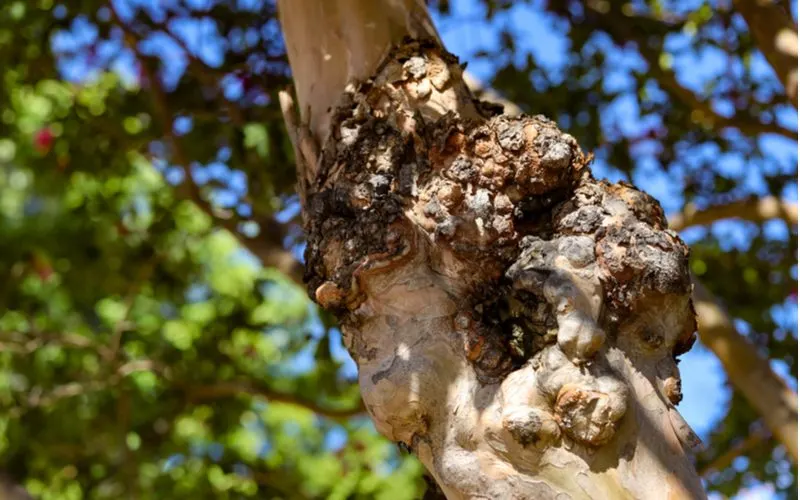
John_P_Anderson/Shutterstock
Crepe myrtle bushes are susceptible to a few diseases, including:
- Aphids
- Fungal leaf spot
- Japanese beetles
- Powdery mildew
- Scale
- Whitefly
To minimize these issues, you should keep the plants apart from each other, at least in terms of spread. You can treat the problems using systemic drenches.
Frequently Asked Questions
Here are some common questions concerning the crepe myrtle bush.
How Do You Turn a Crepe Myrtle Into a Tree?
You can create a shapely tree from a single- or multi-stemmed crepe myrtle by identifying a solid shoot to train as a trunk. Remove the other shoots and stake the trunk.
Cut off the lower branches to expose the bottom half of the trunk. Repeat as it grows, thinning the stronger stems that look like competition to the trunk.
Are Crepe Myrtles Bad?
Experts consider crepe myrtles potentially invasive because of how quickly the tree sprouts from the seeds. It could crowd out native plants if the seed escapes cultivation.
Most crepe myrtles for sale are hybrids without seeds, so you will not experience significant spread throughout your yard.
How Fast Do Crepe Myrtles Grow?
Crepe myrtles grow at a medium to fast rate of one to two feet each year.
So, How Do You Cultivate a Crepe Myrtle Bush?
Cultivating a crepe myrtle bush is easy! If you live in a warm climate, you can plant them in your garden for a gorgeous wash of color. Get started today by planting a crepe myrtle in your yard.

